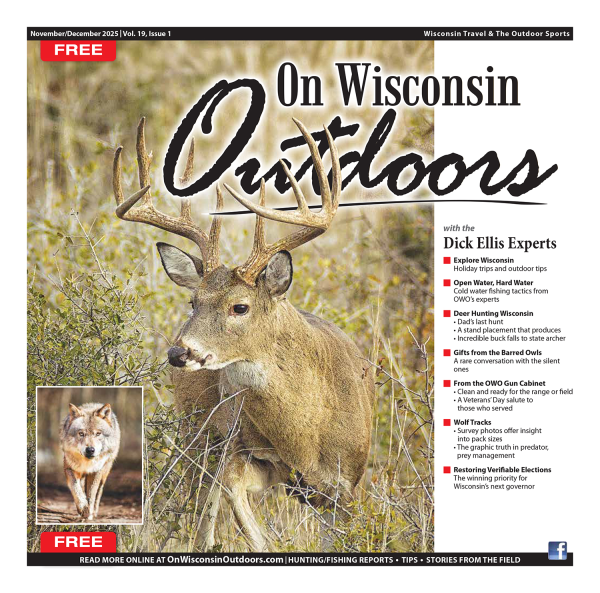A COLD TRAIL...Dropping temperatures push woodcock south
By Dick Ellis
Reader Note: This journey was taken in Vilas County near Manitowish Waters in 2005. For information on public hunting lands, fishing guides, lodging, dining, or entertainment contact the Manitowish Waters Chamber of Commerce and Executive Director Mary Beth Leopold at 888-626-9877 or connect at www.manitowishwaters.org or chamber@manitowishwaters.org.
There was no bell hanging from Maggie’s neck to track the English setter’s eternal and frantic search for woodcock through a young Vilas County aspen cut. But a complete and sudden silence was speaking clearly to the hunter on the logging road ready to welcome a long overdue flush with two steel barrels of a weathered over-and-under.
“I think she may be locked up on a bird,” said Dick Henske after several previous searches in likely habitat over five miles had produced not a single flush of grouse or timberdoodle. “If I don’t move in there Maggie might stay on point for ten minutes. When she’s not wearing her bell the big problem can be in just finding her.”
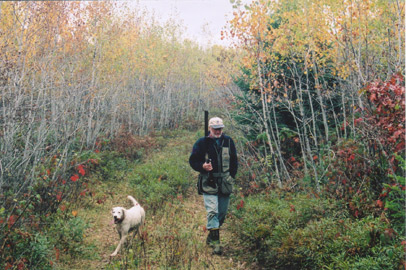 |
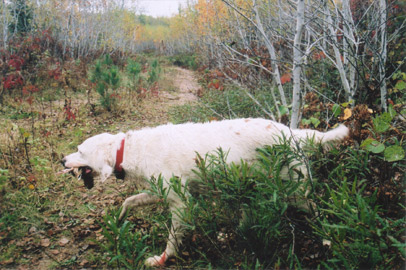 |
| Dick Henske and Maggie try a young aspen stand in Vilas County after flushing no wood cock or grouse in three different sections of habitat. They flushed four woodcock in 20 minutes, bagging two. Note the leaves still on the upper section of aspen still making shooting difficult as of October 7. | Maggie breaks the aspen stand with another woodcock in her mouth destined for Dick Henske waiting on the logging road. The next two weeks usually of cold weather usually send the greatest migration of woodcock through Wisconsin. |
Henske has played this too fleeting game for decades with the red or white blurs of Irish and English Setters. Woodcock travel when cold northern air pushes these migrating birds to warmer places south from Canada, and northern regions of Minnesota, Michigan and Wisconsin. Too much October cold over an extended period and the Wisconsin migration can seem non-existent. When mild weather lingers, though, the woodcock will linger in Wisconsin and good hunting with it.
“By this time last year I was shooting woodcock but the big push should really begin in about a week,” said the 70 year old retired elementary school teacher from Manitowish Waters. “I hope this cold (temperatures in the thirties the morning of October 7) doesn’t send them right through Wisconsin.”
With the woodcock’s primary diet being earthworms, travel and survival is literally weather-dependent. At an average weight of 7.6 ounces for females and 6.2 ounces for males, a woodcock will eat its weight in worms each day. Frozen ground means no access to their food, which are extracted from the earth with long, probing beaks.
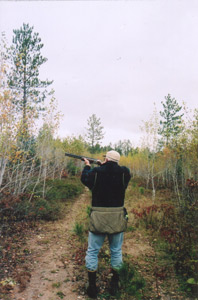 |
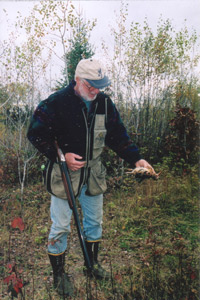 |
| When his English Setter, Maggie, flushes another woodcock from a Vilas County immature aspen stand, Dick Henske of Manitowish River swings and fires. This bird fell. | Dick Henske looks over another migrating woodcock taken from a Vilas County aspen stand. The retired educator has learned much in the field and on the home front. “Mariel isn’t fan of these as table fare,” he said of his wife and gourmet cook. “I have to sneak the woodcock in when she’s making one of her venison dishes.” |
Because the woodcock needs worms, their habitat of choice is much the same as the ruffed grouse, only wetter. Rich dark soil holding their forage base is the key, terrain often found in stream or river-bottom areas with tag alder.
Henske travels afield daily almost without exception to hunt. Using a beat up old Nissan car probably worth less than the gas to fill the tank, he finds the logging roads that often offers access to the prime habitat. Not only does he find birds, he saves his truck the bangs and scratches of the backcountry.
“The newer techniques of the logging industry have meant less access to prime country,” he said. “They use these big rubber tired logging trucks with the saws attached right to the trucks. There’s less use of men with chain saws and a less extensive logging road system. The grouse hunting has still been pretty good, the woodcock will be picking up and when the leaves fall from the tops of these trees the shooting will be easier. Right now, that’s right where the birds are by the time I get my gun up.”
As of the first week in October, Henske and Maggie had tallied a half-dozen grouse with increasing woodcock numbers just beginning to indicate the early push south. Henske said he generally finds the woodcock in a more mixed habitat of aspen, and pine than is primarily preferred by grouse, but the first several searches in that terrain Friday offered nothing but exercise for Maggie.
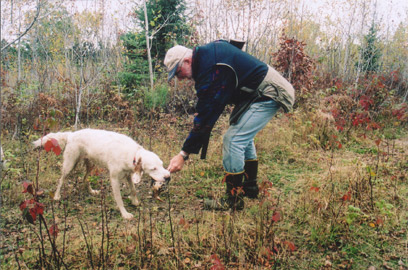 |
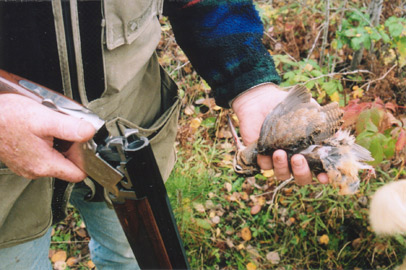 |
| 70 year old retired elementary principal Dick Henske of Manitowish Waters accepts another woodcock from Maggie and offers praise after the English Setter flushed four birds in twenty minutes from a young, Vilas County aspen stand. | The long beak of the migrating woodcock used in probing worms. Cold weather and frozen dirt sends the birds south where finding their primary forage food is easier. |
The move to an immature aspen cut was stereotypical of our morning’s discussion, and the official book, on grouse and woodcock hunting. Young trees growing in the wake of a logging project left us hopeful of grouse. Soft dirt left us hopeful of woodcock. And when Maggie did find the woodcock, the night aviators were found in numbers spread over the same habitat offering food and daytime rest from the flight; but not in flocks or coveys.
One by one over 200 yards, Maggie would point and a woodcock would eventually rise vertically to clear the aspen before continuing its escape. With each flush, air passing through rapidly beating wing feathers produced the unique whistling sound that adds to the excitement of the woodcock hunt.
Three times in the aspen cover or from adjacent logging roads, the report of an over and under shotgun interrupted the music of wings. Twice in the echo of those shots, Maggie had yet another, familiar job to do.
“She lives for this,” said Henske as another old friend in a long line of old friends laid a woodcock in his hands. “All fall, she sleeps on the gun case so I can’t get out of the house without her.”
MORE ABOUT THE NIGHT AVIATOR
Woodcock travel correlates closely with cold fronts signaling the approach of winter, according to this reporter’s internet research and DNR biologist interviews. The first good frost, usually in the first half of October, initiates the push.
From early October on depending on weather, woodcock migrate at low altitudes at night, resting and feeding in secluded thickets during the day. The woodcock has been given a unique probing tool to reach worms at times of rest on the migration. The bird can probe the ground and on a kind of hinge open the end of the bill without opening the entire bill. Sensitive nerve endings in the lower third of the bill, according to internet information, helps locate earthworms. The special bone-muscle design then allows it to open that “mandible”. The long tongue and underside of the mandible are rough-surfaced to grasp and pull slippery prey from the ground.
As nocturnal aviators during the migration, many woodcock are killed during night flying accidents, contributing to the birds’ life expectancy of 1.8 years. Woodcock, though, are hardy, and will often recover from injuries that would kill other birds.
Disease and hunting contribute to the woodcock’s mortality. Heading north too early after wintering in the Carolinas, Georgia, northern Florida, Texas, Arkansas, Louisiana and southwest Mississippi and encountering late snows and freezes can also seal off the woodcock’s food supply, leading to an early demise.
Unlike other birds, the woodcock produces only one nest annually with three or four offspring. Counter-balancing mortality challenges, nest success is a high 60 to 75 percent, and the woodcock enjoys low juvenile mortality.
The overall health of the woodcock is such that hunters in the United States harvest 1.1 million birds annually.
